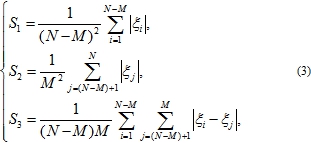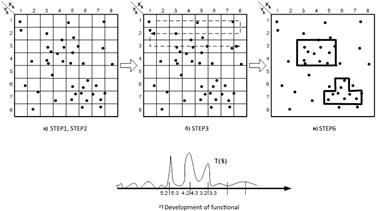РАЗРАБОТКА АЛГОРИТМА ОПРЕДЕЛЕНИЯ ПРОСТРАНСТВЕННО-ВРЕМЕННОЙ РАЗЛАДКИ В СЕТЯХ ОПЕРАТОРА МОБИЛЬНОЙ СВЯЗИ
Зотов К. Н.1, Кузнецов И. В.2, Симбирцева Д. С.3, Жданов Р.Р.4
1Кандидат технических наук, 2Доктор технических наук, 3Студент спец. Инфокоммуникационные технологии и системы связи, 4Кандидат технических наук, Уфимский государственный авиационный технический университет
РАЗРАБОТКА АЛГОРИТМА ОПРЕДЕЛЕНИЯ ПРОСТРАНСТВЕННО-ВРЕМЕННОЙ РАЗЛАДКИ В СЕТЯХ ОПЕРАТОРА МОБИЛЬНОЙ СВЯЗИ
Аннотация
В статье рассмотрена возможность использования теории разладки для нахождения пространственно-временных изменений трафиковых процессов на заранее позиционированных массах абонентов сети связи.
Ключевые слова: теория разладки, пространственно-временная разладка, трафиковые процессы.
Zotox K. N.1, Kuznetsov I. V.2, Simbirtceva D. S.3, Zhdanov R.R.4
1Candidate of Technical Sciences, 2Doctor of Technical Sciences, 3Student, 4Candidate of Technical Sciences, Ufa State Aviation Technical University
DEVELOPMENT OF THE ALGORITM TO IDENTIFY SPACE AND TEMPORAL CHANGES IN CELLULAR OPERATOR NETWORKS
Abstract
Current abstract observes possibility of use the theory of change to identify space and temporal changes in traffic processes on the subscribers positioned in advance. Keywords: theory of change, traffic process, space and temporal changes.The functioning process of cellular systems is accompanied by sudden congestion in separate parts caused by moving of the subscribers. It makes necessary to provide the operational control of radio resources.
First thing for efficient management of radio resources is positioning of mobile stations (MS) with enough accuracy to identify areas of change [1, 5].
There are many different ways to identify the position of subscribers, such as means of the mobile network [2] or global navigation systems [3].
The data obtained from positioning of subscribers are represented in a big range of array as it is impossible to process every subscriber. The efficient management system proposes clustering of all the subscribers of given, find the parts with abnormal change of MS concentration and identify node of demand (ND) inside each of the clusters. Node of demand (ND) shows the most concentrated loading level in the local part of service area that needs additional radio resources.
The NDs obtained are subject to connection with existing network of cellular operator. It makes by creating the models of situational and adaptive planning [4] it also helps to control the whole network with efficiency.
Each cluster consists of points (x;y), where x,y are solid axes showing the location of subscriber characterized by its feature.
The theory of changed [6] which has some limitations is to define borders for abnormal areas during the process of initial clustering:
- Every existing case should be chosen the criterion of algorithm of change.
- It is difficult enough to find the starting value to obtain from model more or less robust information of change.
- Opening of clusters in abnormal areas.
Main task of clustering concerning management of radio resources of cellular network is to define borders (coordinates) of clusters that are aggregative sources of messages and classify traffic of these sources. In addition task salvation should take place in real time. Clustering algorithm based on change will help to identify quantity of necessary clusters. This quantity will give opportunity to apply the algorithms of fuzzy clustering. Hence the prior task in finding NDs is to define borders of abnormal areas in time and space.
Features of the theory of change:
- Invariance for the law of distribution (aprioristic uncertainty conditions).
- Static processing by analyzing data arrays that can change.
- Invariance for counting (does not depend on mark point) [7].
- Possibility to define the quantity of iterations by introduction of constraint system.
The clustering algorithm based on change shown in following steps:
- Definition of positioning of MS (x;y) during the step.
- Splitting investigated area into sub-areas with a step equal to the average value of positional error (frame overlay).
- Definition of change boarders in sample. Functional T(S) is fulfilled by formula:

where ![]() – value of functional with increasing loading,
– value of functional with increasing loading, ![]() – with decreasing loading, and both functions existed in
– with decreasing loading, and both functions existed in ![]() , where
, where ![]() – actual time,
– actual time, ![]() – discrete time, defined by real conditions:
– discrete time, defined by real conditions:

where N and M are geometrically relate (fig. 1), N – developed length of functional T(S), ξ – loading value for basic station at a time.
4. Union of sets of values of T (S) into one:
Fig. 1 – Algorithm of clustering based on change
References
- Vestnik UGATU (scientific journal of Ufa State Aviation Technical University), Vol. 17, No. 2 (55), pp. 14-20, 2013.
- Electrotechnical and information complexes and systems, Ufa, 2013, №1, T.9, 89-93 pages.
- Technologies and means of communication, Moscow, 2010, №3, 26-27 pages.
- Vestnik UGATU (scientific journal of Ufa State Aviation Technical University), Vol. 15, No. 3 (43), pp. 128-133, 2011.
- A. A. Soshnikov, N. P. Vorob’ev, T. E. Titov “Control of electromagnetic environment at sites with sources of electromagnetic radiation”, in Polzunovski vestnik, no. 4, pp. 64-68, 2012.
- Thesis abstract. Zotov KN, UGATU, Ufa, 2014. - 16 pages.
- Zhiglavsky AA, Kraskovsky AE, Detection of desorders of casual processes in problems of radio engineering, St.Petersburg. – 1988. - 224 pages.
